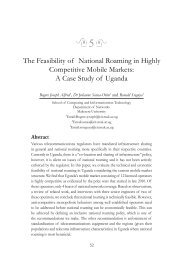Undergraduate Handbook - School of Computing and Informatics ...
Undergraduate Handbook - School of Computing and Informatics ...
Undergraduate Handbook - School of Computing and Informatics ...
Create successful ePaper yourself
Turn your PDF publications into a flip-book with our unique Google optimized e-Paper software.
Reference Books:<br />
i. T. Connolly <strong>and</strong> C. Begg, Database Systems: A Practical Approach to Design, Implementation <strong>and</strong><br />
Management, 2nd edition, Addison-Wesley, 2004.<br />
CSC 2113: S<strong>of</strong>tware Engineering (4 CU)<br />
Course Description: This course introduces students to the foundations <strong>of</strong> s<strong>of</strong>tware engineering as a discipline.<br />
Students are introduced to the evolving role <strong>of</strong> s<strong>of</strong>tware engineering, especially with emphasis on s<strong>of</strong>tware<br />
engineering process <strong>and</strong> process models. Key topics covered include S<strong>of</strong>tware configuration management,<br />
Requirement analysis, S<strong>of</strong>tware Specification, Design methods, S<strong>of</strong>tware testing, S<strong>of</strong>tware project management<br />
techniques; S<strong>of</strong>tware project planning, Risk management; S<strong>of</strong>tware Quality Assurance; S<strong>of</strong>tware reuse; <strong>and</strong><br />
Computer aided s<strong>of</strong>tware engineering: CASE tools <strong>and</strong> application.<br />
Indicative Content<br />
• Evolving role <strong>of</strong> s<strong>of</strong>tware, s<strong>of</strong>tware characteristics; Systems <strong>and</strong> environment; system engineering<br />
hierarchy, information <strong>and</strong> knowledge engineering; Information strategy; Business Area analysis, modeling<br />
enterprise <strong>and</strong> business-level data modeling, system architecture <strong>and</strong> associated information flow; writing<br />
system specification.<br />
• S<strong>of</strong>tware Engineering as a layered technology: S<strong>of</strong>tware process, s<strong>of</strong>tware process models. S<strong>of</strong>tware<br />
configuration management: the SCM process, Identification <strong>of</strong> objects in s<strong>of</strong>tware configuration, version<br />
control, change control, configuration audit, SCM st<strong>and</strong>ards.<br />
• Requirement analysis: Communication techniques, Information gathering tools; organizing <strong>and</strong> structuring<br />
information; analysis principles; Analysis modeling.<br />
• S<strong>of</strong>tware Specification: Design process, principles <strong>and</strong> concepts: Abstraction, refinement, modularity,<br />
control hierarchy, structural partitioning, information hiding, functional independence, cohesion, coupling,<br />
design heuristics;<br />
• Design methods: data design, architectural design, transform mapping, design optimization, human<br />
computer interface design, procedural design <strong>and</strong> tools; Design documentation.<br />
• S<strong>of</strong>tware testing: Testing objectives, Testing principles, Testability, test case designing, white box testing;<br />
Basis path testing: Condition testing, data flow testing, loop testing; Black box testing: graph based testing<br />
methods, equivalence partitioning, Boundary value analysis, comparison testing; Testing documentation<br />
<strong>and</strong> help facilities; S<strong>of</strong>tware testing strategy: unit testing, integration testing, validation testing, system<br />
testing.<br />
• S<strong>of</strong>tware project management techniques: project metrics, s<strong>of</strong>tware measurement <strong>and</strong> metrics, s<strong>of</strong>tware<br />
quality metrics;<br />
• S<strong>of</strong>tware project planning: objectives <strong>of</strong> planning, resources, project estimation <strong>and</strong> estimation models,<br />
project decomposition techniques, make-buy decisions; automated estimation tools.<br />
• Risk management: s<strong>of</strong>tware risks, risk identification, risk projection, risk mitigation, monitoring <strong>and</strong><br />
management; Project Scheduling: people <strong>and</strong> effort relationships, defining tasks, defining task network,<br />
scheduling techniques; S<strong>of</strong>tware teams <strong>and</strong> intra-team relationships; role <strong>of</strong> project manager.<br />
• S<strong>of</strong>tware Quality Assurance: Concept <strong>of</strong> quality, quality control vs. quality assurance, cost <strong>of</strong> quality,<br />
factors that affect quality, quantitative view <strong>of</strong> quality, quality metrics, defect removal efficiency SQA<br />
activities, ISO st<strong>and</strong>ards <strong>and</strong> CMM practices, SEI levels, S<strong>of</strong>tware reviews, Formal approaches to SQA,<br />
Statistical Quality Assurance. S<strong>of</strong>tware reliability, reliability metrics, reliability models, meeting reliability<br />
requirements.<br />
• Effective metrics for s<strong>of</strong>tware process: Measurement principles, attributes <strong>of</strong> s<strong>of</strong>tware metrics, metrics for<br />
analysis model, metrics for design model, metrics for source code, metrics for maintenance.<br />
• S<strong>of</strong>tware reuse: difficulties in reuse, hardware reuse vs. s<strong>of</strong>tware reuse, reusable artifacts, domain<br />
33

















